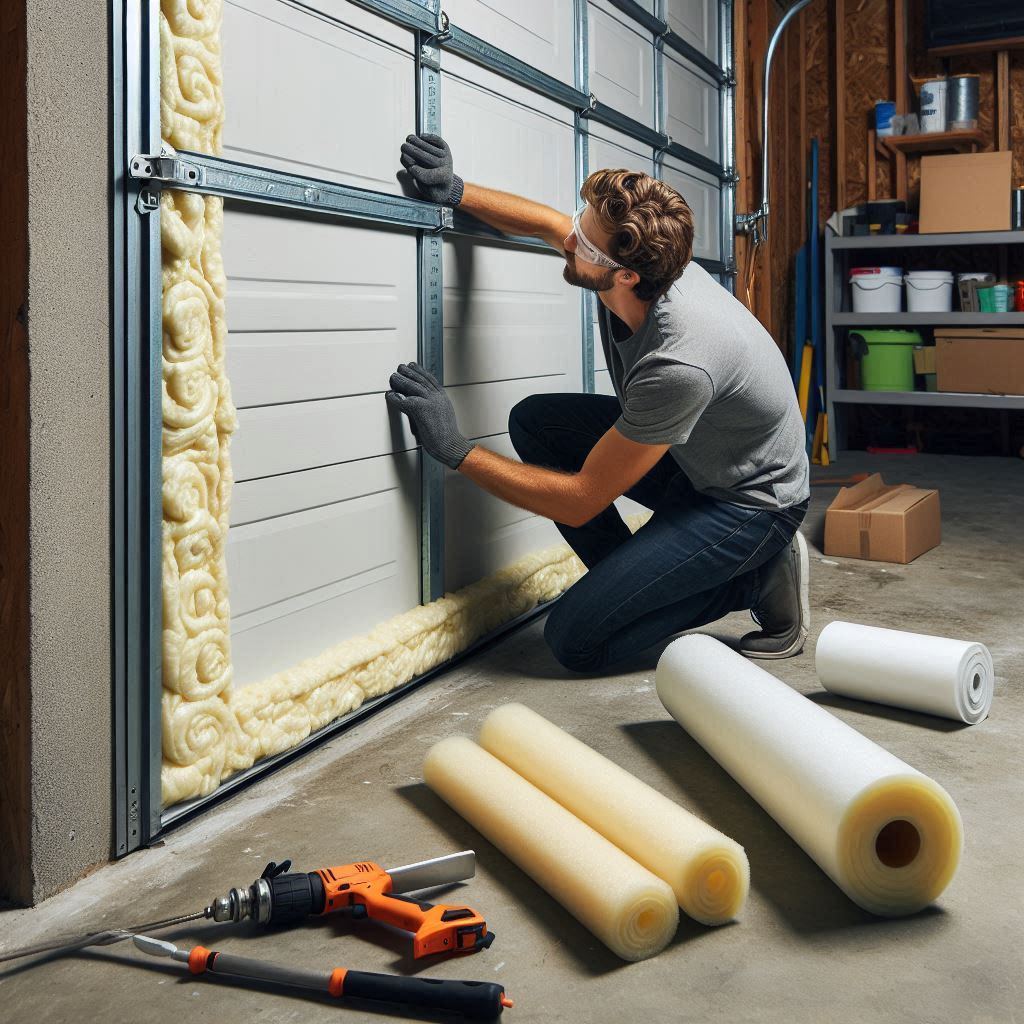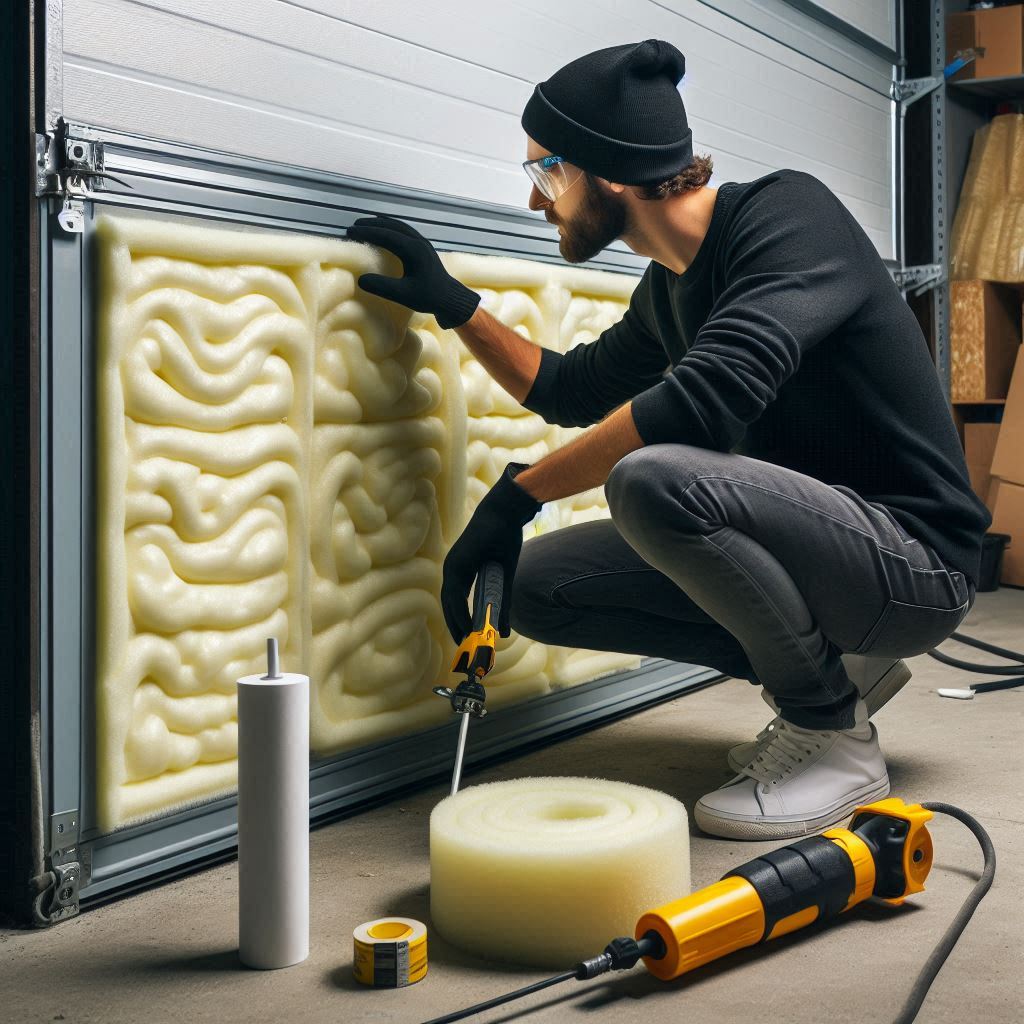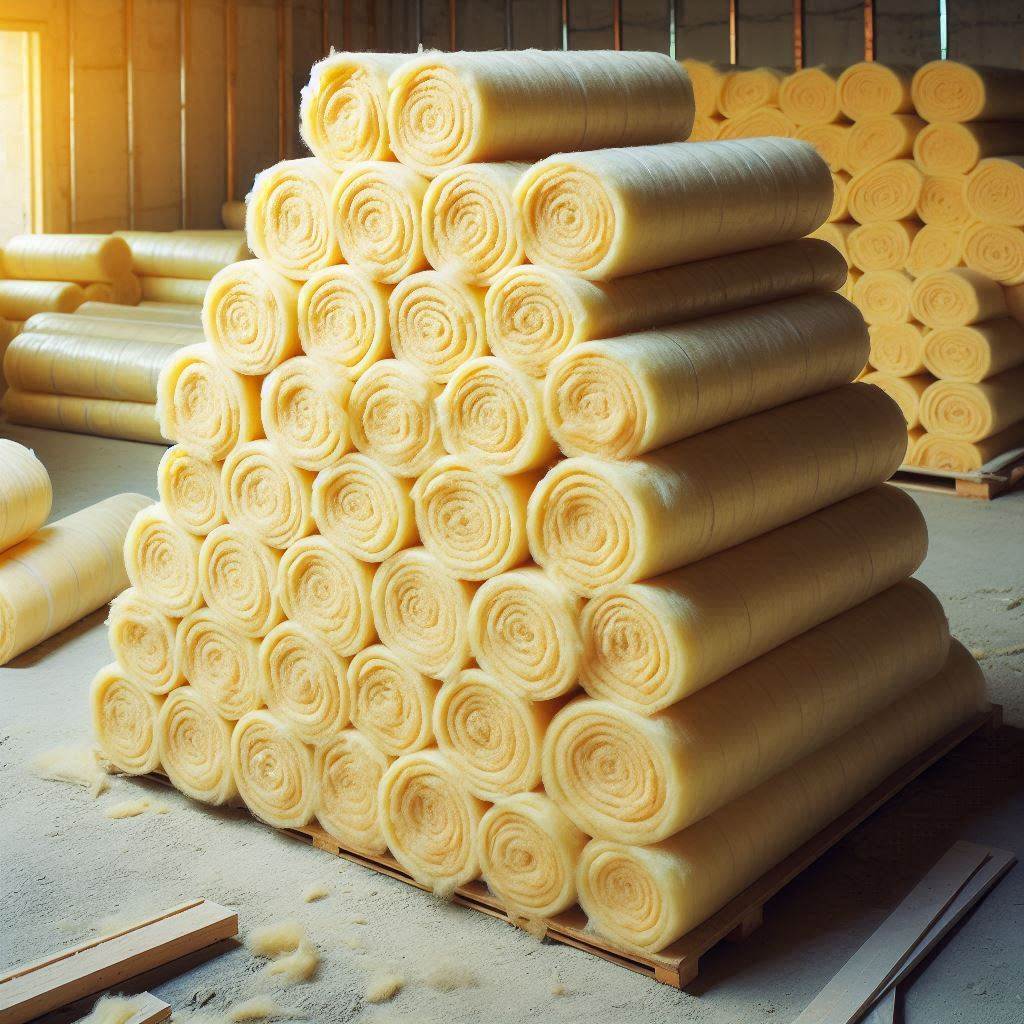
Insulating your garage door is a smart and effective way to enhance the overall comfort and efficiency of your home. Whether you’re looking to keep the garage warmer in the winter, cooler in the summer, or simply reduce noise, proper insulation can make a significant difference.
This guide will walk you through the steps to insulate your garage door, using easy-to-find materials and straightforward techniques, so you can enjoy a more functional and energy-efficient space.
How To Insulate A Garage Door

Materials Needed
Before you begin, gather the following materials:
- Garage door insulation kit: Typically includes insulation panels or rolls, fasteners, and adhesive.
- Measuring tape: For accurate measurements of the door panels.
- Utility knife or scissors: To cut the insulation material to size.
- Straightedge or ruler: Helps in making precise cuts.
- Safety glasses and gloves: For protection while handling materials.
- Cleaning supplies: Mild detergent, sponge, and towel for cleaning the door surface.
Step-by-Step Guide to Insulating Your Garage Door
1. Measure the Garage Door Panels
To start, you’ll need to measure your garage door panels:
- Height and Width
Measure the height and width of each panel on your garage door. Accurate measurements ensure that the insulation fits properly. - Note the Type of Door
If your garage door has recessed panels, measure the recessed area specifically to ensure a snug fit for the insulation.
2. Choose the Right Insulation Material
Selecting the right insulation material is crucial for effectiveness. Here are some common options:
- Polystyrene Foam Board
This material provides good insulation, is lightweight, and easy to cut. It’s ideal for fitting into standard garage door panels. - Reflective Foil Insulation
Reflective foil insulation is great for hot climates as it reflects heat away from the garage. It’s simple to install with adhesive or tape. - Fiberglass Insulation
Fiberglass offers excellent thermal insulation but requires careful handling due to its bulkiness and the potential for skin irritation.
3. Prepare the Garage Door
Proper preparation of the garage door is essential for the insulation to adhere and perform well:
- Clean the Surface
Use a mild detergent to clean the garage door panels, removing any dust or grime. Ensure the surface is completely dry before moving on. - Check for Gaps
Inspect the garage door for any gaps or areas that might need sealing. Applying weatherstripping around the edges can help prevent air leaks.
4. Cut the Insulation
Once you have your measurements, it’s time to cut the insulation:
- Measure and Mark
Transfer your measurements to the insulation material, marking where you need to cut. - Cut the Insulation
Using a utility knife or scissors, carefully cut the insulation pieces to match the size of the garage door panels.
5. Install the Insulation
Now that the insulation is cut to size, it’s time to install it:
- Insert the Insulation
Place each cut piece of insulation into the corresponding garage door panel. For foam board, the pieces should fit snugly within the panel recesses. - Secure the Insulation
If your insulation kit includes adhesive or fasteners, use them to secure the insulation in place. Some kits come with clips that attach to the door to hold the insulation securely.
6. Seal the Edges (Optional)
For added insulation and to prevent drafts, consider sealing the edges:
- Reflective Foil Tape
If using reflective foil insulation, seal the edges with foil tape to enhance insulation and prevent air leaks. - Weatherstripping
Applying weatherstripping around the edges of the garage door further prevents air leaks and improves insulation.
7. Test the Door
After installing the insulation, check the door’s functionality:
- Balance and Function
Ensure the door is properly balanced and operates smoothly. The added weight of the insulation might require adjustments to the spring tension. If the door struggles to open, consult a professional.
8. Inspect and Maintain
Regular maintenance will keep your garage door insulation in good condition:
Clean the Insulation
Occasionally wipe down the insulation to remove dust and keep it clean and effective.
Regular Checks
Periodically inspect the insulation for any signs of wear or damage. Replace any sections as needed to maintain efficiency.
Benefits Of Insulate A Garage Door

Insulating your garage door offers several advantages that can improve the functionality, comfort, and efficiency of your garage and home. Here are some of the key benefits:
1. Improved Energy Efficiency
- Temperature Control: Insulating your garage door helps to regulate the temperature inside the garage, making it warmer in the winter and cooler in the summer. This can reduce the amount of energy needed to heat or cool your home, especially if your garage is attached.
- Lower Energy Bills: By maintaining a more consistent temperature in the garage, your heating and cooling systems won’t have to work as hard, potentially leading to lower energy bills.
2. Enhanced Comfort
- Year-Round Comfort: An insulated garage door helps maintain a comfortable environment in the garage, making it a more usable space year-round. This is particularly beneficial if you use your garage as a workshop, gym, or additional living space.
- Reduced Drafts: Insulation minimizes drafts and cold spots, creating a more pleasant atmosphere, especially during colder months.
3. Noise Reduction
- Quieter Operation: Insulated garage doors tend to operate more quietly than non-insulated ones, reducing noise when opening and closing the door.
- External Noise Reduction: Insulation also helps block out external noise, making your garage and adjoining rooms quieter. This is particularly useful if you live in a noisy area or close to a busy street.
4. Increased Durability
- Strengthens the Door: Insulating your garage door can add strength and durability, making it more resistant to dents, dings, and other damage.
- Longer Lifespan: The added layer of insulation can protect the door’s internal components from temperature fluctuations and moisture, potentially extending the lifespan of the door.
5. Better Protection for Stored Items
- Temperature Control: Insulated garages provide a more stable temperature, which is beneficial for protecting items stored in the garage, such as tools, equipment, and vehicles, from extreme temperatures.
- Moisture Control: Insulation helps to reduce moisture buildup, which can prevent rust and mold growth on stored items.
6. Increased Home Value
- Attractive Feature: An insulated garage door can be an appealing feature for potential buyers, adding to the overall value of your home.
- Energy Efficiency Appeal: With growing awareness of energy efficiency, having an insulated garage door can be a selling point if you decide to put your home on the market.
7. Environmental Benefits
- Reduced Carbon Footprint: By improving the energy efficiency of your home, an insulated garage door can contribute to a lower carbon footprint, making your home more environmentally friendly.
8. Versatility
- All-Season Use: Insulating your garage door makes the garage a more versatile space that can be used for a variety of purposes, regardless of the season.
- Improved Comfort for Adjacent Rooms: Insulation can also benefit rooms adjacent to the garage, reducing temperature fluctuations and improving overall comfort in your home.
Insulating your garage door is a worthwhile investment that offers a range of benefits, from improved energy efficiency and comfort to enhanced durability and noise reduction. Whether you use your garage for storage, work, or as an extension of your living space, insulation can make it a more functional and enjoyable area.
Why Should You Insulate Your Garage?

Insulating your garage is an often-overlooked home improvement project that can offer numerous benefits, both immediate and long-term. Whether you use your garage for parking, storage, or as an additional living space, here are compelling reasons why you should consider insulating it:
1. Enhanced Energy Efficiency
- Temperature Regulation: Insulation helps to maintain a more consistent temperature inside your garage, reducing the need for excessive heating in the winter and cooling in the summer. This is especially important if your garage is attached to your home, as temperature fluctuations in the garage can affect the overall energy efficiency of your house.
- Lower Utility Bills: By improving the insulation in your garage, you can reduce the workload on your HVAC system, leading to lower energy consumption and reduced utility bills.
2. Increased Comfort
- Year-Round Usability: A well-insulated garage stays warmer in the winter and cooler in the summer, making it a more comfortable space for various activities. Whether you use it as a workshop, gym, or hobby area, insulation ensures a more pleasant environment throughout the year.
- Reduced Drafts: Insulating your garage can significantly cut down on drafts, creating a more stable indoor climate and improving comfort, especially in adjacent rooms.
3. Protection for Stored Items
- Temperature and Moisture Control: Insulation helps to stabilize the temperature and reduce moisture levels inside the garage, protecting items stored within from the damaging effects of extreme heat, cold, and humidity. This is particularly beneficial for vehicles, tools, and other sensitive equipment.
- Preventing Rust and Mold: By controlling moisture, insulation can help prevent rust on metal objects and mold growth on stored items, preserving their condition over time.
4. Noise Reduction
- Quieter Operation: An insulated garage door typically operates more quietly, reducing noise when opening and closing. This can be a significant benefit if your garage is located near living spaces or bedrooms.
- External Noise Blocking: Insulation also helps to block out external noise, making the garage a quieter space and reducing the amount of noise that enters your home from outside.
5. Increased Durability and Lifespan
- Protection from Temperature Extremes: Insulating your garage can protect the structure and contents from the harmful effects of temperature extremes, which can cause materials to expand, contract, and deteriorate over time.
- Enhanced Door Durability: Insulating your garage door adds strength and rigidity, helping it withstand wear and tear better, which can extend its lifespan.
6. Improved Home Value
- Attractive Selling Point: A well-insulated garage can be a selling point for potential homebuyers, as it adds to the overall energy efficiency and usability of the home.
- Investment Return: The money spent on insulating your garage can often be recouped through energy savings and increased home value, making it a smart investment in the long term.
7. Environmental Benefits
- Reduced Energy Consumption: By insulating your garage and reducing the need for heating and cooling, you can lower your home’s overall energy consumption, contributing to a smaller carbon footprint.
- Sustainable Living: Insulation is a key component of sustainable home design, helping you live more environmentally consciously while enjoying the practical benefits.
8. Versatile Space Usage
- Expanded Living Space: Insulation can transform your garage into a more versatile space that can be used for a variety of purposes, from a workshop to a home office, gym, or even an extra living area. This flexibility can enhance your quality of life and make better use of your home’s square footage.
- Comfort for Adjacent Rooms: Insulating your garage can also benefit rooms adjacent to the garage, reducing temperature fluctuations and improving overall comfort throughout your home.
Fiberglass Insulation (Batts or Rolls)

Fiberglass insulation is a popular and effective option for insulating various parts of a home, including garage walls and ceilings. Available in both batts and rolls, fiberglass insulation is known for its excellent thermal performance, ease of installation, and affordability. Here’s a closer look at why fiberglass insulation might be the right choice for your garage.
What is Fiberglass Insulation?
Fiberglass insulation is made from fine glass fibers woven together to create a material that effectively traps air, slowing down the transfer of heat. It is commonly used in residential and commercial construction to insulate walls, ceilings, and floors.
- Batts: Pre-cut sections of fiberglass insulation designed to fit between standard framing studs, joists, or rafters. They are easy to handle and install, especially in new construction or unfinished spaces.
- Rolls: Long, continuous sheets of fiberglass insulation that can be cut to fit any space. Rolls offer more flexibility in installation, making them ideal for larger areas or spaces with irregular dimensions.
Benefits of Fiberglass Insulation
1. Excellent Thermal Performance
- Energy Efficiency: Fiberglass insulation provides a high R-value (a measure of thermal resistance), which helps to maintain consistent indoor temperatures and reduce energy costs.
- Climate Versatility: Suitable for both hot and cold climates, fiberglass insulation is effective in keeping the heat out during summer and retaining warmth in the winter.
2. Cost-Effective
- Affordable: Fiberglass insulation is one of the most cost-effective insulation materials on the market, making it a popular choice for homeowners looking to improve energy efficiency without breaking the bank.
- Long-Lasting: When properly installed, fiberglass insulation can last for decades, offering long-term savings on energy bills.
3. Easy to Install
- DIY-Friendly: Both batts and rolls of fiberglass insulation are relatively easy to install, making it a popular choice for DIY projects. Pre-cut batts are particularly straightforward for standard-sized wall cavities, while rolls can be customized to fit any space.
- Flexible Application: Whether you’re insulating a new build, retrofitting an existing garage, or adding insulation to an unfinished attic, fiberglass batts and rolls can be adapted to suit various needs.
4. Fire Resistance
- Safety: Fiberglass insulation is naturally fire-resistant, providing an added layer of safety for your home. It doesn’t burn easily and can help slow the spread of fire.
5. Noise Reduction
- Soundproofing: Fiberglass insulation also helps to reduce noise transmission, making it ideal for garages that double as workshops, studios, or other activity spaces. It dampens sound from both inside and outside the garage.
Installation Tips
1. Measure and Cut
- Accurate Measurements: Before cutting, measure the space you need to insulate carefully. Use a straightedge and a sharp utility knife to cut the fiberglass insulation to size.
- Wear Protective Gear: Always wear gloves, long sleeves, safety glasses, and a dust mask when handling fiberglass insulation to protect against irritation from the fibers.
2. Fit the Insulation
- Install Batts: Place the batts between the wall studs or ceiling joists, making sure they fit snugly without being compressed. Compressed insulation loses its effectiveness.
- Install Rolls: Unroll the insulation and cut it to length. Gently press it into place, ensuring it covers the entire area evenly.
3. Secure and Seal
- Secure the Insulation: Use insulation supports, staples, or other fasteners to hold the insulation in place. Ensure it remains in position and doesn’t sag or shift.
- Seal Gaps: After installation, seal any gaps or seams with caulk or weatherstripping to maximize the insulation’s effectiveness.
Does Insulating A Garage Door Make A Difference?

insulating a garage door can make a significant difference in various aspects of your home’s comfort, energy efficiency, and even the functionality of your garage space. Here’s a breakdown of the key benefits and why insulating your garage door is worth considering:
1. Improved Energy Efficiency
- Temperature Regulation: An insulated garage door helps to maintain a more consistent temperature inside the garage. This is especially beneficial if your garage is attached to your home, as it can reduce the amount of heat transfer between the garage and living spaces.
- Lower Energy Bills: By minimizing temperature fluctuations, your heating and cooling systems don’t have to work as hard, which can lead to reduced energy consumption and lower utility bills.
2. Enhanced Comfort
- Year-Round Usability: Insulating your garage door makes the space more comfortable in both summer and winter, allowing you to use the garage as a workshop, gym, or additional living area regardless of the season.
- Reduced Cold Spots: For attached garages, insulation helps reduce cold drafts that can seep into adjacent rooms, making your entire home more comfortable.
3. Noise Reduction
- Quieter Operation: Insulated garage doors tend to be quieter when opening and closing compared to non-insulated doors. This is particularly beneficial if the garage is near bedrooms or living spaces.
- External Noise Reduction: Insulation also helps block out external noise, making your garage and adjacent rooms quieter, which is helpful if you live in a noisy neighborhood.
4. Increased Durability
- Strength and Stability: Insulating your garage door adds extra layers of material, which can make the door stronger and more resistant to dents, dings, and other damage.
- Longevity: The additional layers provided by insulation can protect the door from wear and tear, potentially extending its lifespan.
5. Better Protection for Stored Items
- Temperature and Humidity Control: Insulating your garage door helps to regulate temperature and humidity levels inside the garage, protecting items stored there from extreme conditions, such as vehicles, tools, and other valuables.
- Preventing Damage: Stable temperatures reduce the risk of rust, mold, and other forms of damage caused by moisture and fluctuating temperatures.
6. Increased Home Value
- Energy-Efficient Feature: An insulated garage door is an attractive feature for potential homebuyers, as it signals improved energy efficiency and comfort.
- Enhanced Curb Appeal: Many insulated garage doors also come in a variety of styles and finishes, which can enhance the aesthetic appeal of your home.
7. Environmental Benefits
- Reduced Carbon Footprint: By improving your home’s energy efficiency, insulating your garage door can contribute to a lower carbon footprint, making your home more environmentally friendly.
Conclusion
Insulating your garage door is a valuable home improvement that offers numerous benefits, including enhanced energy efficiency, improved comfort, and better protection for stored items. By selecting the right type of insulation and following proper installation techniques, you can transform your garage into a more functional and pleasant space.
Whether you choose to do it yourself or hire a professional, the investment in insulating your garage door will pay off through reduced energy bills, increased home value, and a more comfortable living environment.
FAQs
Q1. What type of insulation is best for a garage door?
A1. The best type of insulation for a garage door depends on your needs and budget. Rigid foam panels are often preferred for their high R-value and ease of installation. Fiberglass batts are another good option, offering good thermal performance and flexibility in fitting. Reflective insulation is effective in hot climates as it reflects heat away. Each type has its own benefits, so choose based on your specific requirements and climate conditions.
Q2. Can I insulate my garage door myself?
A2. Insulating a garage door is typically a DIY-friendly project. Most insulation kits come with detailed instructions, making it accessible for those with basic tools and skills. The process involves cutting the insulation to size, attaching it to the door panels, and sealing any gaps. If you’re unsure or uncomfortable with the task, you might consider hiring a professional to ensure proper installation.
Q3. How much does it cost to insulate a garage door?
A3. The cost of insulating a garage door varies based on the type of insulation and the size of the door. DIY insulation kits generally range from $50 to $200. Professional installation can cost between $200 and $600, depending on materials and labor. While upfront costs may vary, the investment can lead to savings on energy bills and increased home comfort.
Q4. Will insulating my garage door reduce noise?
A4. Insulating your garage door can help reduce noise both from the outside and the operation of the door. Insulated doors are generally quieter and provide some degree of soundproofing, making them ideal if your garage is near living spaces or if you experience external noise disturbances.
Q5. How long does it take to insulate a garage door?
A5. Insulating a garage door usually takes between a few hours to a full day, depending on your experience level and the complexity of the door. Most DIYers can complete the project in a few hours if they have the right tools and follow the instructions carefully. Professional installation may take less time and ensure a precise fit.
